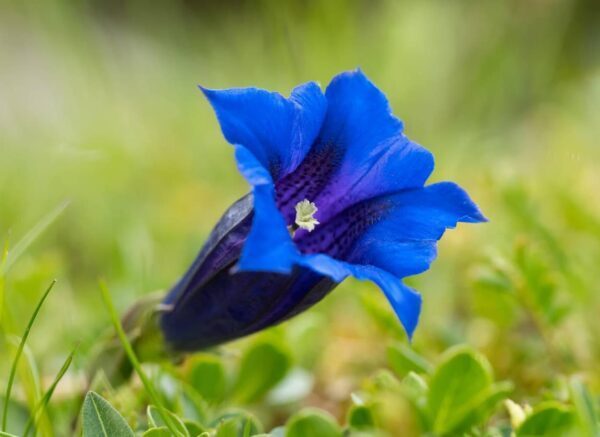- Introduction
- Gentian: a plant that is second to none
- Types of gentian
- Traditional uses of gentian
- Modern medical applications of gentian
- Conclusion
1. introduction
Discover the world of gentian, a remarkable medicinal plant that has been native to the Alps for centuries and is prized for its impressive medicinal properties. Known for its deep blue flowers and as a symbol of purity and endurance, gentian not only plays a central role in traditional herbal medicine, but has also found its place in modern medicine. The unique composition of bitter compounds, particularly in gentian root, offers a wide range of health benefits, from aiding digestion to supporting liver function and detoxifying the body.
In this article, you will learn everything you need to know about different types of gentian, from Gentiana lutea, the yellow gentian, to the exotic Japanese herb gentian and the mystical blue gentian. You will gain an insight into the traditional uses of this plant, its role in herbal medicine and how it has been used to treat loss of appetite, digestive problems, stomach complaints and much more. We also cover modern medicinal uses of gentian, examine the effects of gentian root and gentian schnapps on health, and look at possible side effects. Immerse yourself in the world of gentian and discover how this traditional medicinal plant is still used today in medicine and beyond.
2. gentian: a plant that is second to none
History and distribution
The gentians, scientifically known as Gentiana are a plant genus within the gentian family (Gentianaceae). This impressive plant, whose name is derived from the Illyrian King Gentius, who lived around 180 to 168 BC, has been valued for its healing properties since ancient times. The king is said to have been the first to discover the healing properties of yellow gentian. The genus Gentiana is distributed almost worldwide and comprises 300 to 400 species, which mainly grow in the temperate zones of the northern hemisphere and in the Andes. Around 35 species are known in Europe, mainly in the Alps.
General features
Gentian species are characterized by their diversity in size and shape. The plants vary from small species only 5 cm tall, such as the stemless gentian, to larger ones that can grow up to 1.4 meters tall, such as the yellow gentian. Most species develop their leaves from a rosette of leaves, and while some species are annual or biennial, there are also evergreen and deciduous varieties. The flowers of the gentian plant are particularly showy and vary in color from intense blue to yellow to red, purple and white. These flowers open wide in the sunshine and close when it rains or is cloudy.
3. types of gentian
Important species, their special features and distribution areas
The genus Gentiana comprises 300 to 400 species worldwide, which mainly thrive in the temperate zones of the northern hemisphere and in the Andes. This species diversity is reflected in different growth forms and locations, from the European mountains to the Asian steppes.
Gentiana lutea
The yellow gentian (Gentiana lutea) is particularly common in the mountains of Central and Southern Europe. This species reaches a height of up to 130 cm and flowers in intense yellow. The root of this plant is traditionally used for the production of gentian schnapps and medicinal tinctures. The yellow gentian prefers calcareous soils and can be found at altitudes of up to 2500 meters.
Gentiana macrophylla
Gentiana macrophyllaknown as large-leaved gentian root, is found in Kazakhstan, Siberia, China, Mongolia and the Far East of Russia. This perennial plant grows to a height of 30 to 60 cm and has dark green, elliptical-lanceolate leaves. The flowers of this species are blue to purple and appear in the axils of the leaves. Particularly noteworthy is the slow growth rate; it can take up to 7 years for G. macrophylla blooms for the first time.
Gentiana clusii
The Clusius gentian (Gentiana clusii), also known as stemless lime bell gentian, is a low-growing species that occurs in the Alps, the foothills of the Alps and the Carpathians. This plant grows to a height of only 5 to 15 cm and forms a basal rosette of leaves. The striking blue flowers open from May to August and thrive best on calcareous dry grassland or gravel at altitudes of up to 2760 meters.
These diverse species demonstrate the broad adaptability of the genus Gentiana to different ecological conditions and emphasize their importance both in nature and in traditional and modern applications.
4 Traditional uses of gentian
Gentian roots, valued for centuries for their healing properties, play an important role in both traditional and modern medicine. Yellow gentian in particular, known for its strong bitter substances, has found many applications in naturopathy.
Medical applications
Gentian root is particularly valued for its appetizing and digestive properties. It has a tonic effect and promotes digestion by stimulating the production of gastric juice. This effect makes it particularly useful after rich meals or for digestive problems such as bloating and flatulence. In folk medicine, it is also used in the post-treatment of patients who have undergone chemotherapy or radiotherapy to alleviate side effects such as loss of appetite or disturbances in the perception of smell and taste.
Use in folk medicine
In traditional medicine, the dried root of the yellow gentian is collected from September to November and used for various applications. The root is used both internally and externally to treat a range of ailments. These include anemia, asthenia and intestinal parasites. It is also used for achylia, a lack of gastric or pancreatic juice, and for muscle flaccidity. Its mild antiseptic effect also makes it a valuable disinfectant for the skin.
The diverse applications of gentian root show how this traditional medicinal plant is used to support healthcare thanks to its unique medicinal properties. Its ability to aid digestion and strengthen the immune system underlines the importance of gentian in traditional and modern medicine.
5. modern medical applications of gentian
Phytotherapy
In modern medicine, the yellow gentian is particularly valued for its versatile healing properties. The roots, rich in bitter glucosides and genziopicrin, play a central role in phytotherapy. They are used effectively to treat indigestion and dyspepsia by stimulating the production of gastric juice and acting as a general tonic. The root of the yellow gentian contains important bitter substances such as gentiopicroside and amarogentin, which not only stimulate the taste buds, but also promote the flow of saliva, gastric juice and bile. These properties are particularly beneficial after rich or particularly fatty meals.
Extraction and utilization process
The extraction of gentian root is a careful and manual process. To obtain the root, it is carefully dug around the plant and gently pulled upwards to preserve its integrity. After extraction, the root can undergo a fermentation process that changes its color to reddish tones and gives it a characteristic smell. The dried root is used in various forms, including herbal teas, mother tinctures, liqueurs, infusions and dried extracts. These products aid digestive function and have exceptional detoxifying properties that are particularly beneficial for the liver.
6. conclusion
For centuries, gentian has proven its place as a remarkable medicinal plant in traditional healing methods as well as in modern medicine. From the diverse species found throughout the world to the specific uses of gentian root, the unique medicinal properties of this plant aid digestion, support liver function and provide natural detoxification options. Gentian's deep roots in traditional medicine and its advanced use in phytotherapy underscore the continued relevance and immeasurable value of this plant genus for health purposes.
The insights into traditional and modern uses provide a comprehensive understanding of the potential health benefits of gentian. However, there remains a large field for further research to explore the full medicinal applications and pharmacological effects in more detail. This overview encourages us to pay attention to the fascinating world of medicinal plants and to continue to explore their value not only in history but also in future medical practice.
FAQs
1. is gentian known as a medicinal plant?
Yes, yellow gentian has been known as an effective medicinal plant since Roman times. It has traditionally been used to treat gastrointestinal problems and rheumatic complaints. Even today, gentian is still valued for its healing bitter substances.
2. which products can be made from gentian?
Various pharmaceutical products are made from gentian root. It is used in alcoholic cough medicines and also serves as the basis for the production of schnapps.
3 What are the health benefits of blue gentian?
Blue gentian is mainly used to alleviate digestive problems such as constipation, flatulence and stomach pain. It promotes the production of gastric juices, which helps against loss of appetite and heartburn. It also loosens solid mucus, making it a useful remedy for colds.
4 What are the health benefits of gentian schnapps?
Gentian schnapps is made from gentian roots, which have many health-promoting properties. They promote the production of bile, have a strengthening effect on the stomach and the entire body, and have anti-inflammatory, antiseptic, antipyretic and cooling effects. Gentian schnapps also supports menstruation and is effective against worm infestation. It is important to know that gentian schnapps contains essential oils, but the bitter substances do not pass into the distillate.











